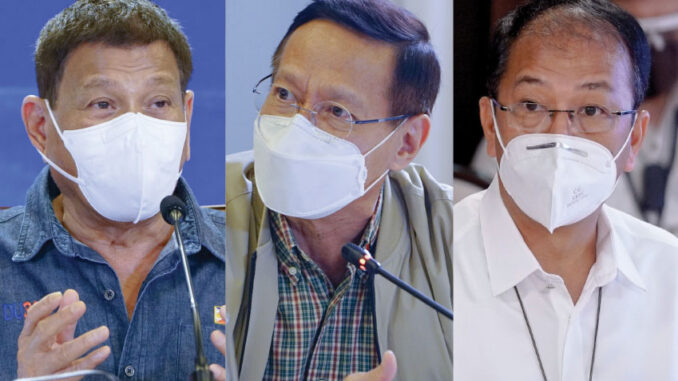
The chief of the Philippines’ economic team Finance Secretary Carlos Dominguez III has told business journalists that while the Philippines may be behind other regional economies at this time in bouncing back from the malaise of the global pandemic, “the country’s recovery will be stronger on the back of its sound economic fundamentals.”
This optimistic forecast is anchored on the structural and tax reforms implemented and are being put in place during President Duterte’s watch, along with “what did not happen” to the economy, which is as important as what did, Dominguez told economic journalists on Tuesday, June 15, 2021.
“We might appear to be behind our neighbors for now, but our recovery will be stronger because of our sound fundamentals,” the Finance chief said.
He said the COVID-19 vaccination program, which “has been rolling out quite well …. gives us hope that we can now fully reopen our economy.”
Indeed, per retired IATF point man Gen. Carlito Galvez last Monday, June 21, the Philippines has hit the 8-millionth-mark in vaccinations. The government has now 14.205 million doses, including the 5.876 million that arrived in the first half of this June. Before June ends, 4 million more doses are arriving. Over the next three months, 5 million doses are coming per month.
Target vaccination sites will be 5,000 from 3,000 at present.
Galvez and Finance Secretary Dominguez have scored a coup of sorts; they wangled from Pfizer a contract for 40 million doses, up from 15 million previously negotiated. Galvez told President Duterte, Philippine Ambassador Babe Romualdez and the State Department helped in securing the 40-million-dose deal.
The breakthroughs in the vaccine rollout have given added swagger to Duterte. He now threatens to arrest the vaccine non-believers or boot them out of the archipelago. Vaccination is mandatory for everyone.
The President warned the courts not to interfere, meaning, do not issue temporary restraining orders to stop government agencies from rounding up non-believers for forced inoculation. In other democracies, forced vaccination is a violation of human rights. “To hell with the criticisms,” blurted Duterte.
Face shields, which no other country in the world uses, are still mandatory.
Visitors to the Philippines must undergo a 10-to-14-day quarantine to block our borders from the entry of the vicious Delta or Indian variant which is 60% more infectious and 40% more deadly.
Why the restrictions? Duterte’s scientists cite science. In the case of face shields, other countries do not believe in its science, apparently. Face shields, some scientists claim, add 10% more protection to what face masks do.
As for having 14-day quarantines for visitors from abroad, UP-educated Dr. Edsel Salvana claims the Delta virus takes up to 14 days to gestate or manifest its presence in a person’s body. Other scientists claim it takes only 5 days for the COVID virus to manifest itself.
So visitors, expect to endure mandatory extended isolation when arriving in the Philippines. From the airport, you ride in a government selected shuttle vehicle, stay in a government-mandated hotel for a minimum of 10 days, undergo government-mandated swabs, and isolate yourself in your room, because you are not allowed visitors.
Meanwhile, at the EJAP forum, Dominguez pointed out the country did not suffer the fiscal downturn that typically accompanies an economic crisis even with the massive expenditures government has incurred as a result of the Covid-19 global economic and health crises.
When the pandemic-induced crisis struck last year, Dominguez recalled, the government “did not have to go back to the drawing board in order to plan for the country’s economic recovery” because “much of the spadework was done” over the last five years of the Duterte administration.
“Clearly, we avoided a lot of trouble. All the strengths that became evident when the challenges were greatest are not due to a stroke of good fortune. This was not luck. This was readiness,” said the Finance chief. “They are the results of many years of fiscal discipline, forward-looking policy reforms, and continuing improvement in our administrative systems—especially through the adoption of new digital technologies.”
The pandemic dealt the Philippines a “heavy blow,” Dominguez conceded, but that is not the full context of the country’s story. Examples of other aspects of the Philippines’ pandemic narrative:
— The government did not fail to collect revenues even when people could not go out of their homes to file their income tax returns and pay their tax dues.
Annual income tax returns (ITRs) filed electronically soared to 90% in 2020 and to almost 100% last April, from just 10% in 2015.
— The government achieved a two-decade high revenue effort at 16.1% of gross domestic product (GDP) in 2019 compared to only 15.1% in 2015. This 2019 feat helped bring down the debt-to-GDP ratio for that year to a historic low of 39.6% from 42.7% in 2015;
— The Philippines kept its high credit rating of BBB+;
— The government never ran out of cash resources and has managed to meet the huge spending on its COVID-19 response despite weakened revenue collection resulting from the on-and-off strict lockdowns;
— The government’s total revenue loss amounted to P1.4 trillion in 2020; P709 billion was financed by borrowings and ODA; and
— The government did not suffer constrained fiscal space despite the recent increase in borrowings as the affordability of the national debt remains manageable.
READ FULL ARTICLE HERE:

